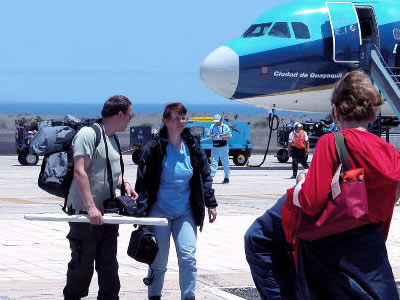Living with diabetes doesn't mean you can't enjoy traveling. Whether crossing the country in an RV or jet-setting to the farthest reaches of the globe. But making sure that you stay healthy and keep your glucose levels under control does require a bit of organization and planning.
The American Association of Diabetes Educators has some suggestions to ensure that your next adventure is safe and successful.
Pack More Medicine
Gone for a week? Pack two weeks' worth of your diabetes medications in case of travel delays or misplaced supplies (insulin, syringes, testing strips, extra batteries for your pump, a first-aid kit, glucagon emergency kit, etc.). If you use a pump, ask the company if you can bring a backup in case yours fails. Have a prescription from your doctor for insulin or oral medication in case of an emergency.
Keep Supplies Safe
Keep your medications and diabetic supplies close at hand and don't put them in checked luggage or in the trunk, where they can be exposed to harmful extreme temperatures (too hot or too cold). If you're flying, keep them in the original packaging (so no one questions they're yours) in a bag separate from your toiletries, as requested by the Transportation Security Administration (TSA), which manages airport security. Don't worry, the TSA allows you to go over the 3.4 liquid-ounce carry-on limit for diabetes medications and supplies.
Identify Yourself
Wear your medical bracelet or necklace that notes you have diabetes and take insulin (if you do). Bring a doctor's note that explains you have diabetes and lists your medications, as well as a prescription in case you need more. Carry a health card that includes your emergency contact and doctor's name and phone number. Learn how to say "I have diabetes," "sugar," and "orange juice, please" in the language of the country you are visiting.
Carry Low Blood Sugar Treatments and Snacks
Low blood sugar (hypoglycemia) can strike any time and food access during travel is unpredictable, so be sure to bring plenty of snacks such as peanut butter crackers, granola bars and trail mix as well as glucose tablets or gel.
Make Flying Simpler
Tell the TSA agents that you are a diabetic (they're trained to accommode people with health issues). Visit the TSA Page for Diabetics before your trip to learn about screening policies. If you plan to inject insulin during flight, be aware - the pressurized air can make it more challenging to draw up your insulin, if using a vial and syringe, so be extra careful not to inject air into the bottle.
Test Frequently
New foods, increased activity and different time zones can throw your glucose levels out of whack, so be sure to test frequently, including before and after meals. If you take insulin, keeping your levels steady can be tricky when changing time zones, so make a plan to adjust your schedule for injecting. Before your trip, find a diabetes educator who can help you with this challenging process.
Take Care of Your Feet
Wear comfortable well-fitting shoes and socks at all times – never go barefoot. Check your feet frequently, especially after a hike or long walk. Feet and ankles often swell during flights so consider wearing light knee-high compression stockings (20-30 mm Hg) or bring thinner socks to change into if your feet swell. Wear a shoe that can be loosened if that occurs. Pointing and flexing your ankles during a flight can improve blood flow in your calf muscles and decrease swelling as well as lower the risk of blood clots.
Be Prepared for Health Emergencies
If you need medical treatment, ask your hotel to recommend a local doctor who treats diabetes. Beore an overseas trip, find a list of local English-speaking doctors through the International Association for Medical Assistance to Travelers.
The secret to any successful trip is to take plenty of time and plan far in advance of your departure - and that goes double when you have diabetes. For more information, learn about how a diabetes educator can help you plan your vacation.
0
AADE









